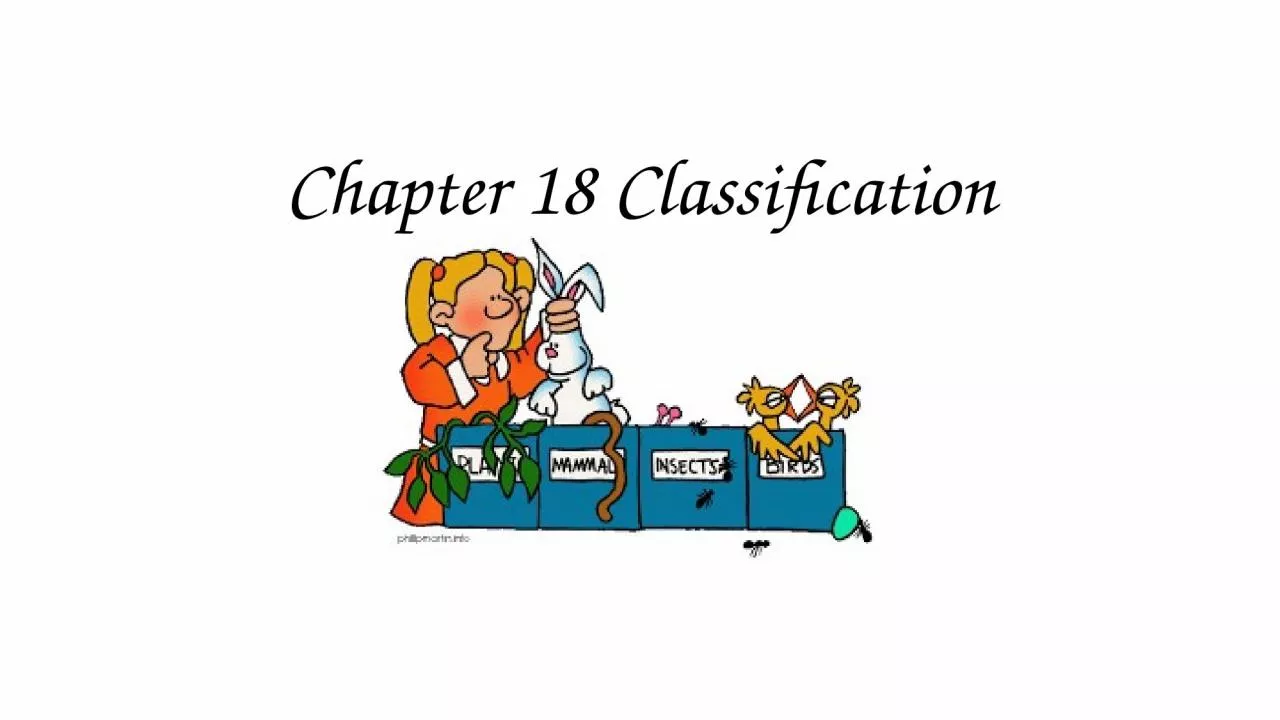

181 Finding Order in Diversity Systematics science of naming and grouping organisms Binomial Nomenclature two word naming system started by Carolus Linnaeus to describe and name each species ID: 1033548
Download Presentation The PPT/PDF document "Chapter 18 Classification" is the property of its rightful owner. Permission is granted to download and print the materials on this web site for personal, non-commercial use only, and to display it on your personal computer provided you do not modify the materials and that you retain all copyright notices contained in the materials. By downloading content from our website, you accept the terms of this agreement.
1. Chapter 18 Classification
2. 18.1 Finding Order in DiversitySystematics – science of naming and grouping organismsBinomial Nomenclature – two word naming system started by Carolus Linnaeus to describe and name each speciesEach species is give a two part name: First part = Genus Second part = speciesBoth are either underlined or italicized: ex: Genus species or Genus speciesNames are in Latin so they are universal Ex. Human = Homo sapiensSystem expanded to include 7 taxaKingdom PhylumClassOrderFamilyGenus Species
3. 18.2Modern Evolutionary ClassificationEvolutionary Classification – the study of evolutionary relationships among organisms; called PHYLOGENYPhylogeny- the study of how living and extinct organisms are related to one anotherClassify/group organisms into categories that reflect lines of evolutionary descent rather than overall similarities and differencesPlace organisms into higher taxa based on relatednessClade – a group of species that includes a single common ancestor (living and extinct)Use Derived Characteristics to assign species to cladesA trait that arose in the most recent common ancestor of a particular lineage and was passed along to its descendantsEx: Felidae clade = retractable claws
4. 18.2Modern Evolutionary ClassificationCladograms – diagrams that show how species and higher taxa are related to each otherShows evolutionary lines, or lineages, branched off from a common ancestorPlaces where the lineage spits is called a fork or nodeNodes represents the point where new lineages last shared a common ancestorThe root (at the bottom) represents the ancestor shared by all of the organism on the cladogramRelies of derived charactersBuilding a Cladogram constructing a cladogram wsBased on the cladogram, are amphibians more closely related to humans or to ray-finned fish?
5. 18.2Modern Evolutionary ClassificationWhat are the derived characters in the cladogram and which groups have those characters?
6. 18.2Modern Evolutionary ClassificationDNA is ClassificationAll organisms have DNA, which can be compared in different species. The more derived genetic characteristics two species share, the more recently the species shared a common ancestor and the more closely related they are.
7. 18.3 Building the Tree of LifeThe tree of life shows current hypotheses regarding evolutionary relationships among taxa within the three domains of lifeCurrent 3 Domain and 6 Kingdom System
8. 18.3 Building the Tree of Life
9. DOMAINS OF LIFE3 Domains of LifeArchaea (prokaryotic)Bacteria (prokaryotic)Eukarya (eukaryotic)
10. DOMAIN BACTERIA Prokaryotic UnicellularCell walls contain peptidoglycanEcologically diverse ranging from free-living soil organisms to deadly parasites.Some autotrophic, some heterotrophicSome need oxygen to survive (aerobic), some are killed by oxygen (anaerobic)Only one kingdom within this domain: Kingdom Eubacteria
11. DOMAIN ARCHAEA ProkaryoticUnicellularCell walls do NOT contain peptidoglycanLive in very harsh environmentsSome autotrophic, some heterotrophicSome need oxygen to survive (aerobic), some are killed by oxygen (anaerobic)Only one kingdom within this domain: Kingdom Archaebacteria
12. IMPORTANCE OF PROKARYOTES1) Ecological Importance: Essential in maintaining every aspect of the ecological balance of the living worldDecomposers – recycling raw materials to the environment, essential to sewage treatment & production of purified waterProducers – cyanobacteria are among the most plentiful photosynthetic organisms in the world & many food chains are dependent upon themNitrogen Fixers – converting nitrogen gas into useable forms2) Human UsesFood – yogurt, other dairy productsMedicine – making drugs for medical treatments3) Disease – some bacteria can cause disease by destroying living cells or by releasing chemicals that upset homeostasisEX’s/ Lyme disease, Tetanus, Tuberculosis, Strep ThroatControlled by sterilization, disinfectantsPrevented by vaccines
13. DOMAIN EUKARYA All Eukaryotes: contain a nucleus & other membrane-bound organellesFour KingdomsProtista (protists)FungiPlantaeAnimalia
14. PROTISTSUnicellular, Colonial, or MulticellularPhotosynthetic or HeterotrophicCatchall kingdom – group of eukaryotes that did not fit into plants, animal or fungus kingdom
15. ECOLOGICAL IMPORTANCE OF PROTISTSAutotrophic Protists – photosynthetic protists at the base of the food chain makes much of the diversity of aquatic life possibleEX/ AlgaeHeterotrophic Protists – some heterotrophic protists engulf and digest their food, while others live by absorbing molecules from the environment.EX/ Paramecium, amoebaSymbiotic ProtistsMutualistic – algae help health of coral reefs, Trichonympha live in guts of termites, helping them to digest celluloseParasitic – can cause intestinal disease, African Sleeping Sickness, & MalariaRed blood cell
16. FUNGIHeterotrophic – feed on dead or decaying organic matter (absorb)Secrete digestive enzymes into their food source, then absorb nutrients though their cell wallsCell walls made of chitinUnicellular (yeasts) or Multicellular (mushrooms)
17. ECOLOGICAL IMPORTANCE OF FUNGIDecomposers – many species of fungi help ecosystems maintain homeostasis by breaking down dead organisms and recycling essential elements and nutrients. Parasites – parasitic fungi can cause serious diseases in plants and animalsEX/smuts and rusts in plantsAthlete’s foot & ringwormSymbiotic Fungi:Lichens – mutualistic association between a fungus and a photosynthetic partner (algae or cyanobacteria). Are often the first organisms to enter barren environments and help in early stages of soil formation. Michorrhizae – mutualistic association between a fungus and a plant root. Estimates that 80-90% of all plant species have this sort of relationship. Fungus collects water and minerals, bringing them to the root, plant supplies the fungi with the products of photosynthesis (sugars).
18. PLANTSMulticellularCell walls with celluloseAutotrophicHave chloroplasts
19. ANIMALSMulticellularHeterotrophicNo cell walls Most can move
20.
21.
22.